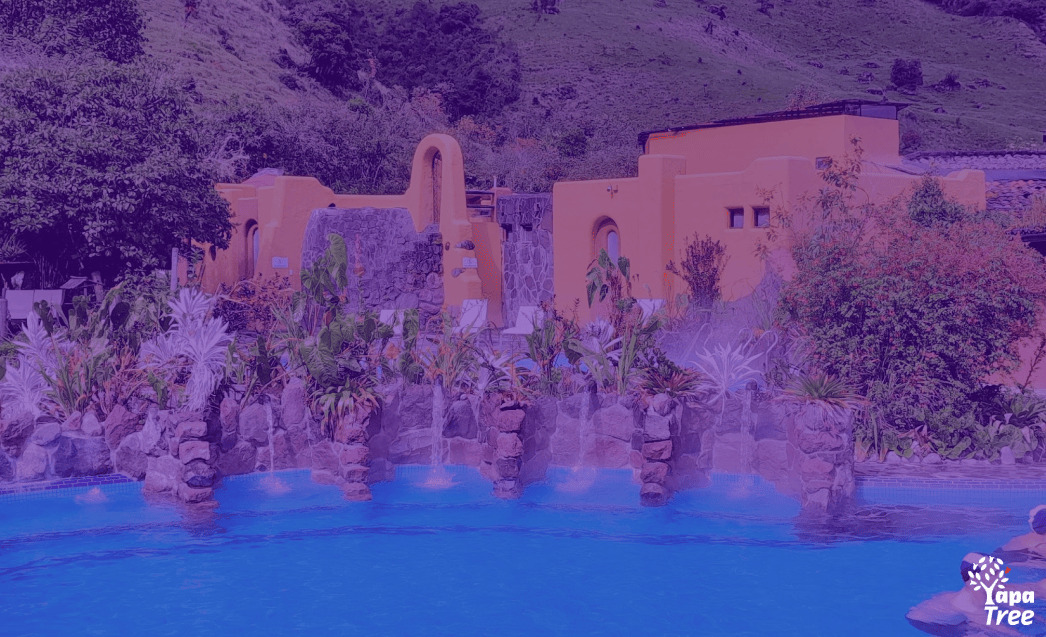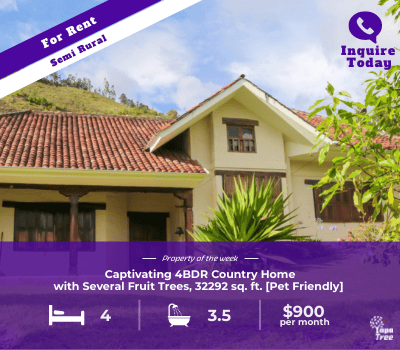Quito and its environs don’t seem to come up much when Cuenca expats talk about traveling in Ecuador. I hear about trips to the coast and the jungle but the Quito area often gets left out of the conversation. I used to regularly cast aspersions on the city itself as just another crowded, dirty Latin American megaplex. But having traveled there numerous times and mostly recently in July as part of a short vacation, I keep finding things I really like about it and some exceptional places and activities near it.
We escaped to the area for 6 days and 5 nights with our first top being Papallacta. We didn’t stint on expenses during this short trip so we spent a bit more every day than we might have on a longer one. So, this article is not a budget guide.
One thing I look for and followed in planning were recommendations for hotels and restaurants from friends who had been to these places. I hate guessing when booking which is what I end up doing when I go down the internet research rabbit hole. Internet descriptions make every place look and sound wonderful but we all know that feeling of disappointment when we arrive and find accommodations and food less than we expected. And my referral strategy paid off.
Quito and Area Trip Summary
So, this series is not an in-depth description of all the things to see and do in the places we visited (Papallacta, Mindo, Otavalo, Cotacachi, and the city of Quito itself.) Instead, you will read more of an overview of what we did, saw, and enjoyed and a few other places and activities that you might also enjoy.
Of course, we didn’t see or do a lot of things we would have liked to because we were on a limited timetable. So, we look forward to exploring the unexplored on our next visit to the area. And we had so much fun that I know we will return to do them.
First Stop: Termas Papallacta

Transport from Cuenca to Papallacta
We splurged and flew to Quito on the first morning rather than go overland. Right now Avianca and Latam both fly there and back to Cuenca. Both of them have bait-and-switch pricing so that what starts out as a $99 fare ends up being $175 if you want to “go wild” and bring a piece of luggage, book a seat in advance, etc. Still, it was much quicker and more pleasant than by bus or buseta or by driving oneself.
And we were able to enjoy the first full day in Papallacta instead of burning it up in an exhausting road slog. Avianca had a much more convenient flight schedule than Latam for us on the outbound and return leg. Latam’s flights seemed disadvantageous for a vacationer wanting to maximize time enjoying themselves at their destination.
After landing, our journey from Quito kicked off at about 8:30 in the morning as we set out from Quito airport in Alex’s by car, making our way through the scenic Cayambe-Coca National Park en route to our destination. The first leg of our trip took us to the Papallacta thermal baths, a perfect opportunity to bask in the warm waters and connect with nature.
My partner had booked a driver who picked us up at Quito airport and drove us up to Papallacta which is about a 2-hour drive. Alex Rojas served as our driver for the whole trip. He proved to be super friendly, reliable, and knowledgeable in Spanish and fluent English. Alex worked for a British tour company as a guide throughout the country for many years and has some formal guide education. I imagine he would make a good guide but we didn’t really lean on him for that skill. He moved us skillfully, safely, and efficiently through the itinerary we had selected with his assistance. His restaurant choices were excellent too and he joined us for several meals en route.
So, I recommend him. Alex Rojas, Driver Whatsapp +593 99 353 6936.

Buses travel from Quito’s Terminal Terrestre Cumandá From Terminal Terrestre and you can catch a bus to Papallacta about every 20 minutes. The trip is only about 40 miles but due to the poor quality of the roads, it usually takes about 2 hours. Some people prefer to take transport arranged by their hotel.
Cayambe-Coca National Park
You may like to know that situated right by the town of Papallacta, the Cayambe-Coca National Park is named after the prominent Cayambe volcano, a stunning peak to the north of Quito. This volcano stands out as Ecuador’s third largest and uniquely, the only snow-capped one to straddle the equator.
Within the park, there are a huge variety of plants and animals and various climates, The park’s centerpiece is the Cayambe volcano (Vulcan) with its many waterfalls.
And one of the park’s special inhabitants is the Andean bear, commonly known as the spectacled bear, an exclusive and endangered species native to the tropical Andes. Keep your eyes peeled and you might just spot one with a distinctive white marking around its eyes resembling eyeglasses.
Papallacta
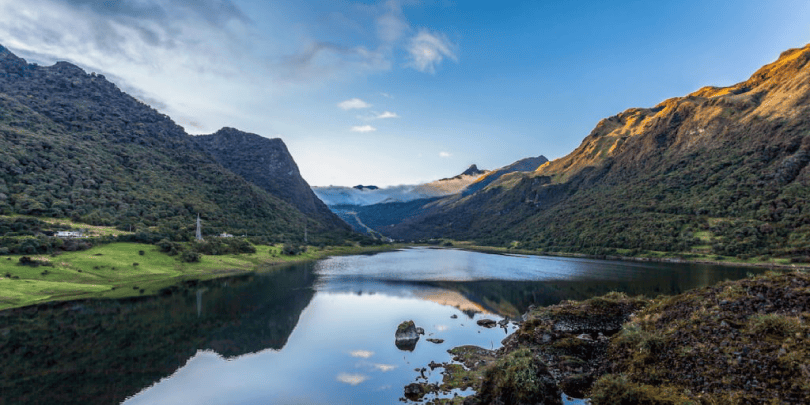
At 3,250 meters, Papallacta is embraced by the picturesque Andean landscape. Despite its proximity to Quito, it now belongs to the province of Napo.
The climate in Papallacta is humid, relatively cold, and wet, at a relatively high elevation in the Andes, at 3,300 meters above sea level. The average day-time temperature in Papallacta is 14°C (57°F). There is little seasonal variation in Papallacta. Although the climate in Papallacta is always dreary, the cold, foggy weather sets a pleasing backdrop for hot springs bathers.
The Resort and Hotel Papallacta
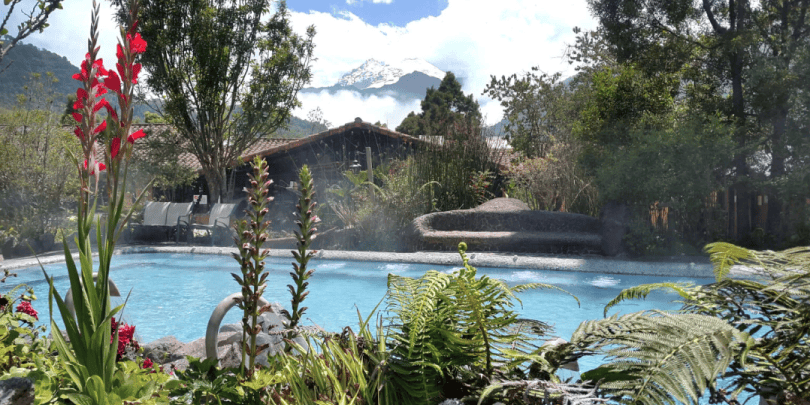
The Hotel Termas de Papallacta has 35 rooms that can handle up to 120 visitors with accommodations As mentioned, a delightful feature is the abundance of pools right by the cabins, inviting you to dip in and unwind whenever you please. It comes with room prices including IVA of between $180 and $230.
I wish we had stayed a Hotel Papallacta and paid the difference between the hotel and Mamallacta Lodge, a short work away which cost between $90 and $130 before IVA. More on Mamallacta is below.
There are actually several sets of baths within and the Spa adjacent to the Hotel Termas de Papallacta. First, the hotel and adjacent Spa each offer their own “piscinas”. The hotel itself offers 2 sets: those sprinkled inside the perimeter of the hotel grounds and available to hotel guests and a lower-cost option called the Balnearios which we did not see or visit. To access the Balanear, a nominal fee of USD 9 grants you entry.
The Balnearios and the Spa each offer their own restaurants, with the spa offering high-end Ecuadorian menu selections with good service but, of course, high-end tourist prices. We enjoyed the adjacent Spa facility that also included changing rooms, showers, toilets, and lockers. Towels were provided as part of the Spa admission and fluff robes were $2.50 each for the visit.
Venturing beyond relaxation, the resort offers access to a protected 200-hectare area ideal for guided hikes. With five different routes, priced between 4-10 USD, you can explore waterfalls, lagoons, and cloud forests. The Loreto River also flows through the landscape.
A diagram of the resort appears below:

The Spa and Piscina Experience – The Big Highlight
The real highlight of Papallacta was the Spa’s collection of 5 large hot Spa pools with differing temperatures including three cooled by a natural stream and others invitingly warmed to around 36 degrees Celsius. The experience was a bit like visiting a Disneyland version of one of Cuenca’s own Baños thermal spas like Novaqua but much bigger, diverse, and more beautifully landscaped. The waters impart believed benefits on intestinal function, offering anti-allergic, anti-inflammatory, diuretic, and anti-rheumatic effects. Of course, the best part is that made us feel great.

The Spa at a higher cost ($23) and with a bit more indulgence than the Balenar is less crowded with a more peaceful experience. Beyond the inviting baths in the Spa building is Club Termal, which is a sanctuary for massages and various treatments catering to relaxation and wellness.
Jumping Into the Pools
After a 2 hour nap at our hotel, Mamallacta Paramo Lodge, and lunch in the Spa restaurant overlooking the piscinas, we checked in at the Spa reception and immersed ourselves in the therapeutic powers of the thermal waters.
And we got our money’s worth, dipping in and out of all 5 pools (avoiding number 6 the ice-cold one) and spending all afternoon immersed in their warmth. The various pools offered a delightful blend of temperatures and sensations. It’s worth noting that the water jets while invigorating, can be quite hot.
The area is blessed with the emergence of warm water streams from the earth. These streams originate from a source where temperatures range from 30°C to 70°C (86°F to 158°F). However, by the time the water reaches the pools, its temperature has noticeably decreased due to travel through pipes and the addition of cold water by the hotels. The hot springs’ water is reputed for its potential health advantages, attributed to its composition of calcium, sulfates, chloride, and sodium. It possesses a mildly salty taste.
Mamallacta Paramo Lodge
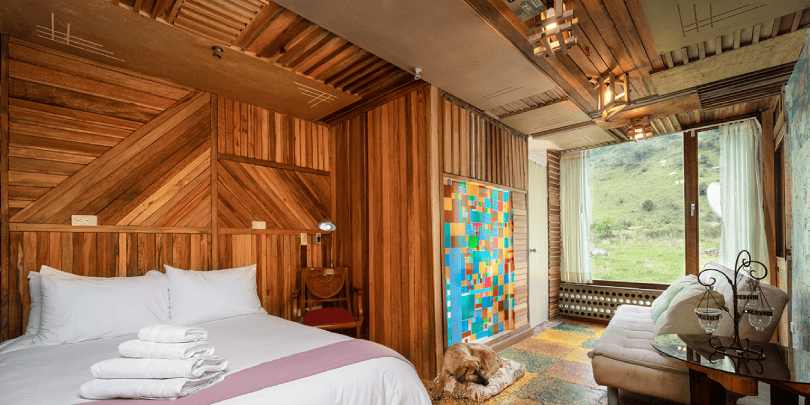
We had just one night to spend in Papallacta and, in retrospect, I feel like we would have been better off paying slightly more to stay at the Papallacta Hotel with its excellent reputation. Instead, we took a chance on a lower-cost option about which we knew only what we saw on its website. But hindsight is 20/20.
Mamallacta Paramo Lodge is far more “earthy”, if more colorful, than the Hotel Papallacta. And though it was only about a block’s walk away, the road to the Spa was muddy and rough. So, if you hike, don’t do it in flip flops as my partner did. The common areas project a more fanciful and fun experience than we actually felt.
The room and bed we were assigned were quite small and very cold. It came equipped with a small electric heater installed in the ceiling which helped with the temperature but kept turning itself off. The room was decorated in an “eclectic” style which might be better described as “funky”. The staff were attentive but I got the feeling that they were struggling mightily to maintain an efficient service level. The word slow came to mind.
Dining

We ate dinner and breakfast at Mamallacta. They served mostly Ecuadorian fare which seemed to work fine for my Ecuadorian partner. But I am not a fan of Ecuadorian food so I ordered Spaghetti for dinner which was 90% noodles and 10% some kind of non-Italian red sauce. I asked for and received more sauce hoping it would improve the dish but it did not. Dinner prices were captive audience levels though not as high as at the resort’s restaurant. Breakfast was not memorable but I think it was included.
We also enjoyed lunch and, later, snacks at the Spa’s restaurant. Prices were tourist-astronomical but the “comida tipica” was actually quite good and the service equally good. We missed out on dining at the Balenera restaurants or at those inside the hotel next door. We checked out the hotel’s restaurant menu and again found captive audience pricing. No surprise there for a hotel restaurant I guess.
After visiting the Spa Piscinas and before dinner at Mamallacta, we had a very reasonably priced meal of a tasty pizza at a family-owned restaurant with a menu that included a vast array of options at the end of the street leading to the resort on the way back to Mamallacta.
We did not have time to really dig into the dining options in Papallacta and you may know of some (Comments please) and/or have more time to do so. But our casual research led us to believe that the town’s dining options aren’t great.
Wrap-up of Day 1 Papallacta
The Spa experience was one of the highlights of our 6 day trip and we enjoyed our afternoon there immensely. I am pretty sure we will stay at the Hotel Papallacta next time because of its superior accommodations and the novelty of its own system of baths that complement those of the Spa. The trip from Quito was brief, fun, and scenic. And we loved the convenience of having our own driver.
In future installments, I will cover the rest of our stops: Mindo, Otovalo, Cotacachi, and the city of Quito. Subscribe to YapaTree in the upper right-hand corner of this page so you don’t miss them!

